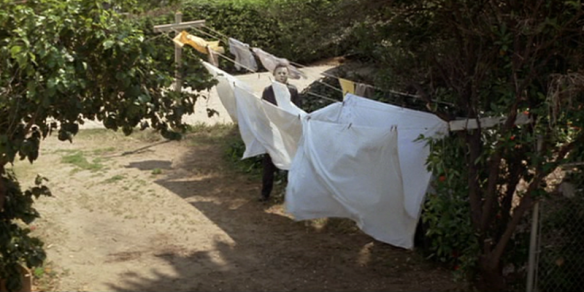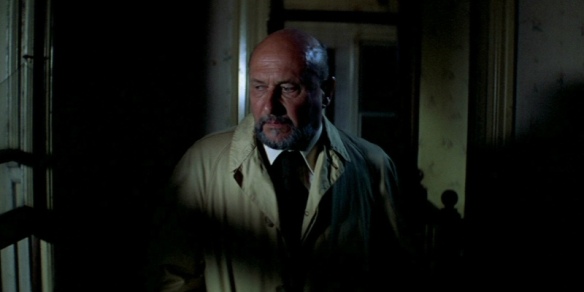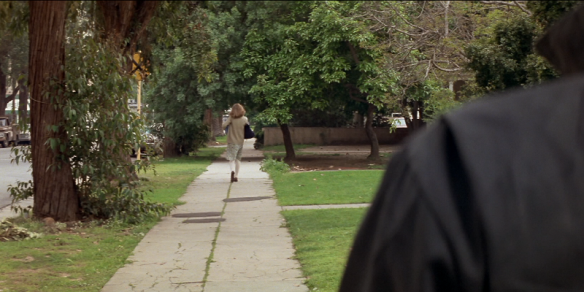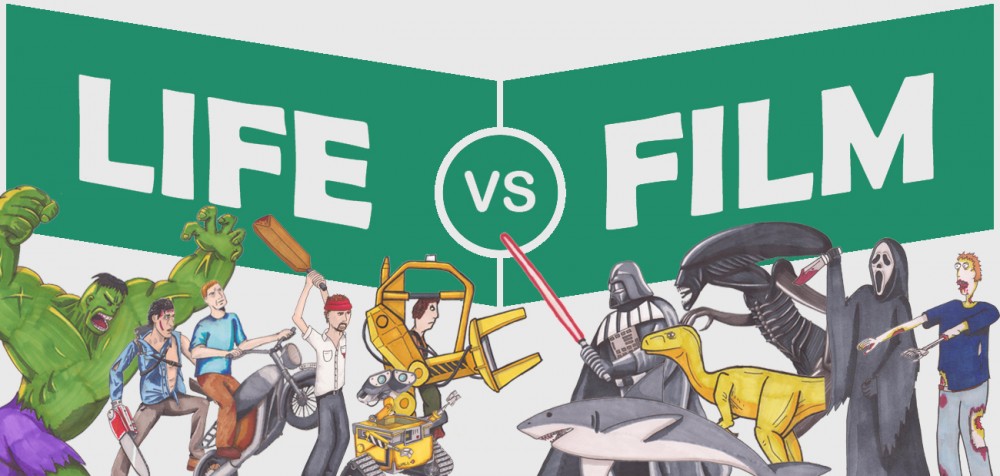In 1963, six year old Michael Myers murdered his older sister with a knife on Halloween night, and was sentenced to a mental institution under the guidance and examination of Dr. Loomis (Donald Pleasence). Fifteen years later, on the day before Halloween, Michael escapes and heads for his home town of Haddonfield, Illinois, with murderous intent.
 Believe it or not, this was my first viewing of Halloween. I haven’t seen any of the sequels or remakes, although I have edited a podcast discussing the entire franchise, a show I did not take part of and didn’t really absorb any information from. However, I have seen a fair few slasher films that have been released since Halloween, most notably the Scream franchise, so unfortunately this didn’t feel as fresh and original to me as it might have done to audiences going in for the first time back in 1978. In fact, the rules of survival from Scream can be drawn directly from Halloween, so whenever anybody had sex, or said “I’ll be right back” on their way to grab a beer, I instantly, without a doubt, 100% knew that character should seriously consider filling out a last will. Other tropes that probably began here (I can’t recall what took place in Peeping Tom, and I’ve not seen what is widely considered the “first slasher”, Black Christmas) are the slow-walking killer that cannot be stopped and the angelic final girl.
Believe it or not, this was my first viewing of Halloween. I haven’t seen any of the sequels or remakes, although I have edited a podcast discussing the entire franchise, a show I did not take part of and didn’t really absorb any information from. However, I have seen a fair few slasher films that have been released since Halloween, most notably the Scream franchise, so unfortunately this didn’t feel as fresh and original to me as it might have done to audiences going in for the first time back in 1978. In fact, the rules of survival from Scream can be drawn directly from Halloween, so whenever anybody had sex, or said “I’ll be right back” on their way to grab a beer, I instantly, without a doubt, 100% knew that character should seriously consider filling out a last will. Other tropes that probably began here (I can’t recall what took place in Peeping Tom, and I’ve not seen what is widely considered the “first slasher”, Black Christmas) are the slow-walking killer that cannot be stopped and the angelic final girl.

Said girl is Laurie Strode (Jamie Lee Curtis), an archetypal good girl who excels at school, saves her babysitting money, doesn’t date or have sex, is reliable and doesn’t mess around, and coughs and splutters at a single toke of weed that her friend Annie (Nancy Loomis) smokes with ease. I knew from her continuation in the series that Laurie would survive and, by virtue of slasher rules, all of her friends would perish in some manner, but the children she was babysitting would get through fine, just a little traumatised. I’ve got nor problem with this cliché. What does drive me insane is the immortal villain. I don’t think it’s too big of a spoiler to discover that at come the end of this film Michael Myers has been incapacitated on his murderous rampage – which Laurie had found herself the prime target of. After having been stabbed, shot several times and fallen from the second storey, Michael’s body was seen sprawled, wrecked and presumably deceased on the lawn, yet a few moments later his body has disappeared in preparation for the sequel. As soon as you imply that there’s nothing you can do to stop this person, no matter how bereft of life he should be, you immediately remove any notion that this could be scary, because now it’s most certainly not real. This film gets a pass because this doesn’t happen until the very last shot, so all the scares before this point are legitimate, but had I been reviewing one of the sequels I’d be calling out some bullshit right here.
 Personal qualms aside, this is actually more innovative than I’d anticipated, even from a modern perspective. The film opens with a shot entirely from the killer’s point of view, as in literally seen through his eyes, but even with this novel concept it still manages to be inventive by at one point adding a mask to the equation, so we see a kill through these limiting windows, and then spinning the camera around to reveal that the killer we’ve been in the mind of is a child wearing a clown costume. For some reason this makes it all the more creepy, with the child brandishing a bloodied knife that’s about half his size.
Personal qualms aside, this is actually more innovative than I’d anticipated, even from a modern perspective. The film opens with a shot entirely from the killer’s point of view, as in literally seen through his eyes, but even with this novel concept it still manages to be inventive by at one point adding a mask to the equation, so we see a kill through these limiting windows, and then spinning the camera around to reveal that the killer we’ve been in the mind of is a child wearing a clown costume. For some reason this makes it all the more creepy, with the child brandishing a bloodied knife that’s about half his size.

Compared to modern films this has an exceedingly low body count and a very slow burn. In fact, I’m reliably informed (by Wikipedia) that the Rob Zombie 2007 Halloween remake has almost the same number of kills this film has in its entire length just in the first scene, and adds a lot more kills at a steady rate through the rest of the film too. With the original, there’s a kill in the opening scene (which I forgot to mention is all in one shot too, so I appreciated it even more) and another off screen after Michael escapes from his asylum and steals a guy’s car, but there’s nothing else until almost an hour in. Instead we have a steady ramp-up of the creep factor. Michael may not be slaughtering innocents left, right and centre, but his presence is keenly felt stalking Laurie wherever she goes. He watches her from his childhood home, breathing heavily with only his shoulder in shot. So much tension and dread is built up just from having this figure stood motionless and staring in an inhuman kind of way. The shot of him looming from amongst the washing lines is just terrific.

The camera has fun with this stalking too. Quite often shots will linger after the actors have walked out of frame, only for Michael to reveal himself somewhere in the shot. Other times, however, the shot will hold for a beat or two longer than usual, only for nothing untoward to happen. This is just as terror-inducing as if Michael had jumped out with a knife, as it means he could be anywhere, and possibly even the film-makers don’t know when he’s going to appear. The variation maintains a high level of tension.
 One issue I did have, and again this is something I’m not even sure is a problem, but I was a little confused as to Michael’s reasons behind targeting Laurie. His motive becomes clear in the sequel, I hear, but in this film it seems like she was just in the wrong place at the wrong time, being required by her father to drop off something into the Myers household whilst Michael is standing and watching from the window. It could be construed that he just went after the first person he saw and killed anyone that was in the vicinity, or he just had a penchant for stabbing babysitters and their boyfriends, either way it’s not defined. It could be very well argued that this makes the film even scarier, the lack of a motive implying this could happen to anyone, so this is quite possibly just my problem, but it does pose the question of whether Carpenter had the sequel reveal planned all along, or he just didn’t want to do too much back story in this film.
One issue I did have, and again this is something I’m not even sure is a problem, but I was a little confused as to Michael’s reasons behind targeting Laurie. His motive becomes clear in the sequel, I hear, but in this film it seems like she was just in the wrong place at the wrong time, being required by her father to drop off something into the Myers household whilst Michael is standing and watching from the window. It could be construed that he just went after the first person he saw and killed anyone that was in the vicinity, or he just had a penchant for stabbing babysitters and their boyfriends, either way it’s not defined. It could be very well argued that this makes the film even scarier, the lack of a motive implying this could happen to anyone, so this is quite possibly just my problem, but it does pose the question of whether Carpenter had the sequel reveal planned all along, or he just didn’t want to do too much back story in this film.
 All in all this is an effective horror film that’s worthy of being known as one of the greatest in the slasher sub-genre. I’m grateful I’ve seen it, but personally I still prefer some of the films that have been heavily influenced by it. As much as you can say there wouldn’t be a Scream without Halloween, I’d still rather watch Scream any day of the week.
All in all this is an effective horror film that’s worthy of being known as one of the greatest in the slasher sub-genre. I’m grateful I’ve seen it, but personally I still prefer some of the films that have been heavily influenced by it. As much as you can say there wouldn’t be a Scream without Halloween, I’d still rather watch Scream any day of the week.
Choose Film 8/10

Nice, I feel the same when i look back on older films that have evolved over time, this genre took a change thanks to friday the 13th which left Halloween sequels copying the high body count leading up to the Scream franchise. this is a film i love, respect but i would also like to have seen blind before seeing where the slasher genre went to truly judge how good or bad it really is but sadly it ends up being a film people including myself hype up for people and are left disappointed with because of how well it builds everything up
I feel like an argument could be made that kids should be shown old films, regardless of how age-appropriate they are, just so they can better understand and appreciate influence and effect. Film Appreciation should be taught in schools, and Halloween would be on the agenda for October. I’d schedule The Cabinet of Dr. Caligari, Nosferatu, Psycho, The Shining and Halloween as being the one-a-week films kids should watch. Also, I want to traumatise them all.
I don’t think there’s any shame in saying you’d rather watch Scream than Halloween. In a lot of ways, Scream is a better film even if it wouldn’t exist without this one.
I had a similar experience a couple of weeks ago when I watched Blood Feast. Let’s not make any mistakes here–Blood Feast is a terrible, terrible film. It is, however, one of the first horror movies to really show explicit gore. So I wonder…would Halloween exist without it? Or The Thing? Or Scream?
It’s back to the old Birth of a Nation debate. Would modern cinema be anywhere near its current state without it? But can we all still pretend it didn’t happen at the same time?
It kind of is. It’s a much easier argument to make for Halloween, though, because it’s a genuinely good movie.
Pingback: My Week in Movies, 2015 Week 44 | Life Vs Film
Wow, wonderful weblog layout! How long have you ever
been blogging for? you make blogging glance easy. The overall glance of your website
is excellent, as smartly as the content material!